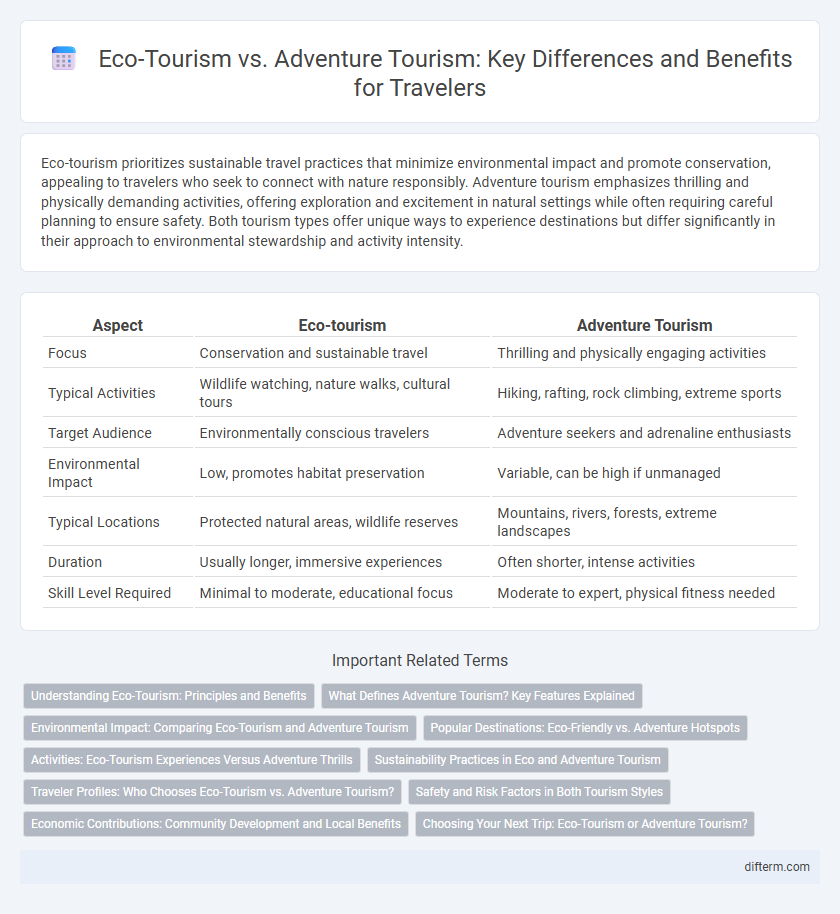Eco-tourism prioritizes sustainable travel practices that minimize environmental impact and promote conservation, appealing to travelers who seek to connect with nature responsibly. Adventure tourism emphasizes thrilling and physically demanding activities, offering exploration and excitement in natural settings while often requiring careful planning to ensure safety. Both tourism types offer unique ways to experience destinations but differ significantly in their approach to environmental stewardship and activity intensity.
Table of Comparison
| Aspect | Eco-tourism | Adventure Tourism |
|---|---|---|
| Focus | Conservation and sustainable travel | Thrilling and physically engaging activities |
| Typical Activities | Wildlife watching, nature walks, cultural tours | Hiking, rafting, rock climbing, extreme sports |
| Target Audience | Environmentally conscious travelers | Adventure seekers and adrenaline enthusiasts |
| Environmental Impact | Low, promotes habitat preservation | Variable, can be high if unmanaged |
| Typical Locations | Protected natural areas, wildlife reserves | Mountains, rivers, forests, extreme landscapes |
| Duration | Usually longer, immersive experiences | Often shorter, intense activities |
| Skill Level Required | Minimal to moderate, educational focus | Moderate to expert, physical fitness needed |
Understanding Eco-Tourism: Principles and Benefits
Eco-tourism emphasizes responsible travel to natural areas that conserves the environment, sustains the well-being of local people, and involves interpretation and education. Its core principles prioritize minimizing impact, building environmental and cultural awareness, and fostering respect for different ecosystems and communities. Benefits include promoting biodiversity conservation, supporting local economies through sustainable practices, and enhancing travelers' appreciation for natural and cultural heritage.
What Defines Adventure Tourism? Key Features Explained
Adventure tourism involves travel experiences that include physical activity, exploration, and a connection with nature, often in remote or challenging environments. Key features include risk-taking elements such as hiking, climbing, or rafting, requiring specialized skills or equipment, and promoting personal growth through overcoming obstacles. Unlike eco-tourism, adventure tourism emphasizes thrill and excitement, although it can incorporate sustainable practices to minimize environmental impact.
Environmental Impact: Comparing Eco-Tourism and Adventure Tourism
Eco-tourism emphasizes minimizing environmental impact by promoting sustainable practices such as wildlife conservation, habitat preservation, and low-impact activities like guided nature walks. Adventure tourism often involves higher environmental risks, including trail erosion, increased waste, and disturbance to ecosystems due to activities like off-road driving, climbing, and high-intensity water sports. Choosing eco-tourism supports biodiversity protection and reduces carbon footprints, making it a more sustainable travel option for environmentally conscious tourists.
Popular Destinations: Eco-Friendly vs. Adventure Hotspots
Costa Rica's Monteverde Cloud Forest Reserve stands out as a premier eco-tourism destination renowned for its biodiversity and sustainable practices, attracting nature enthusiasts worldwide. For adventure tourism, Queenstown, New Zealand, offers adrenaline-pumping activities such as bungee jumping, skydiving, and white-water rafting, making it a global hotspot for thrill-seekers. The distinct appeal of eco-friendly destinations lies in conservation and low-impact travel, whereas adventure hotspots emphasize extreme sports and high-energy experiences.
Activities: Eco-Tourism Experiences Versus Adventure Thrills
Eco-tourism activities emphasize sustainable interactions with natural habitats, including wildlife watching, guided nature walks, and conservation volunteering, designed to minimize environmental impact. Adventure tourism focuses on high-energy experiences such as rock climbing, white-water rafting, and zip-lining that offer adrenaline-pumping challenges in diverse landscapes. Both offer unique ways to explore nature, with eco-tourism prioritizing education and preservation, while adventure tourism highlights physical excitement and risk management.
Sustainability Practices in Eco and Adventure Tourism
Eco-tourism prioritizes conservation efforts, minimizing environmental impact through sustainable lodging, wildlife preservation, and community engagement. Adventure tourism incorporates sustainability by promoting low-impact activities, using eco-friendly gear, and supporting local economies to reduce footprint. Both sectors emphasize responsible travel practices that protect natural habitats and cultural heritage.
Traveler Profiles: Who Chooses Eco-Tourism vs. Adventure Tourism?
Eco-tourism travelers typically prioritize sustainability, cultural immersion, and environmental conservation, often comprising environmentally conscious individuals, nature lovers, and educational groups. Adventure tourism attracts thrill-seekers and adrenaline enthusiasts, usually younger demographics seeking physical challenges and high-energy activities such as rock climbing, white-water rafting, or trekking. Understanding these traveler profiles helps businesses tailor experiences that meet the distinct motivations driving eco-tourism and adventure tourism markets.
Safety and Risk Factors in Both Tourism Styles
Eco-tourism emphasizes low-impact activities that prioritize environmental conservation, resulting in generally lower safety risks due to controlled, guided experiences in natural habitats. Adventure tourism involves higher-risk activities such as climbing, rafting, and extreme sports, requiring rigorous safety measures and experienced guides to mitigate potential hazards. Travelers must assess personal risk tolerance and ensure proper equipment and training when participating in adventure tourism to enhance safety.
Economic Contributions: Community Development and Local Benefits
Eco-tourism generates sustainable income by promoting conservation and supporting local businesses, fostering long-term community development through educational programs and environmental preservation. Adventure tourism drives significant short-term economic growth by attracting high-spending travelers interested in activities like trekking, rafting, and climbing, which boosts employment in guiding and equipment rental services. Both sectors contribute to local benefits, with eco-tourism focusing on minimizing ecological impact while adventure tourism emphasizes infrastructure investment and job creation.
Choosing Your Next Trip: Eco-Tourism or Adventure Tourism?
When choosing your next trip, eco-tourism offers immersive experiences in pristine natural environments, emphasizing conservation and sustainable travel practices, often including activities like wildlife observation and cultural immersion. Adventure tourism prioritizes adrenaline-pumping activities such as rock climbing, whitewater rafting, and mountain biking, appealing to travelers seeking physical challenges and excitement in diverse landscapes. Balancing environmental responsibility with thrill-seeking, your choice hinges on whether you prioritize ecological preservation or high-intensity exploration.
Eco-tourism vs Adventure tourism Infographic

 difterm.com
difterm.com